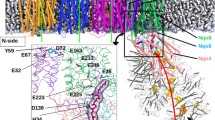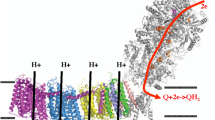Abstract
Proton transfer in cytochrome c oxidase (CcO) from the cellular inside to the binuclear redox centre as well as proton pumping through the membrane takes place through proton entrance via two distinct pathways, the D- and K-channel. Both channels show a dependence of their hydration level on the protonation states of their key residues, K362 for the K-channel, and E286 or D132 for the D-channel. In the oxidative half of CcO’s catalytic cycle the D-channel is the proton-conducting path. For this channel, an interplay of protonation state of the D-channel residues with the water and hydrogen-bond dynamics has been observed in molecular dynamics simulations of the CcO protein, embedded in a lipid bi-layer, modelled in different protonation states. Protonation of residue E286 at the end of the D-channel results in a hydrogen-bonded network pointing from E286 to N139, that is against proton transport, and favouring N139 conformations which correspond to a closed asparagine gate (formed by residues N121 and N139). Consequently, the hydration level is lower than with unprotonated E286. In those models, the Asn gate is predominantly open, allowing water molecules to pass and thus increase the hydration level. The hydrogen-bonded network in these states exhibits longer life times of the Asn residues with water than other models and shows the D-channel to be traversable from the entrance, D132, to exit, E286. The D-channel can thus be regarded as auto-regulated with respect to proton transport, allowing proton passage only when required, that is the proton is located at the lower part of the D-channel (D132 to Asn gate) and not at the exit (E286).






Similar content being viewed by others
References
Ädelroth P, Gennis RB, Brzezinski P (1998) Role of the pathway through k (i-362) in proton transfer in cytochrome c oxidase from R. sphaeroides. Biochemistry 37(8):2470–2476
Babcock GT, Wikström M (1992) Oxygen activation and the conservation of energy in cell respiration. Nature 356:301–309
Bagga Jay, Heinz Adrain (2002) Jgraph—a java based system for drawing graphs and running graph algorithms. In: Mutzel Petra, Jünger Michael, Leipert Sebastian (eds) Graph drawing, vol 2265. Lecture notes in computer science. Springer, Berlin, pp 459–460
Baker EN, Hubbard RE (1984) Hydrogen bonding in globular proteins. Prog Biophys Mol Biol 44:97–179
Belevich I, Bloch DA, Belevich N, Wikström M, Verkhovsky MI (2007) Exploring the proton pump mechanism of cytochrome c oxidase in real time. Proc Natl Acad Sci USA 104:2685–2690
Bondar AN, Smith JC (2009) Water molecules in short- and long-distance proton transfer steps of bacteriorhodopsin proton pumping. Isr J Chem 49:155–161
Brändén Gisela, Pawate Ashtamurthy S, Gennis Robert B, Brzezinski Peter (2006) Controlled uncoupling and recoupling of proton pumping in cytochrome c oxidase. Proc Natl Acad Sci USA 103(2):317–322
Brzezinski P, Adelroth P (1998) Proton-controlled electron transfer in cytochrome c oxidase: functional role of the pathways through Glu 286 and Lys 362. Acta Physiol Scand Suppl 643:7–16
Son CY, Yethiraj A, Cui Q (2017) Cavity hydration dynamics in cytochrome c oxidase and functional implications. Proc Natl Acad Sci USA 114(42):E8830–E8836
Chaumont A, Baer M, Mathias G, Marx D (2008) Potential proton-release channels in bacteriorhodopsin. ChemPhysChem 9:2751–2758
Cover TM, Thomas JA (2006) Elements of information theory. Wiley, New York, p 19
Cukier RI (2005) A molecular dynamics study of water chain formation in the proton-conducting k channel of cytochrome c oxidase. Biochim Biophys Acta Bioenerg 1706(1):134–146
Darden T, York D, Pedersen LG (1993) Particle mesh Ewald: an Nlog(N) method for Ewald sums in large systems. J Chem Phys 98:10089–10092
Dellago C, Naor MM, Hummer G (2003) Proton transport through water-filled carbon nanotubes. Phys Rev Lett 90:105902
Goyal P, Yang S, Cui Q (2015) Microscopic basis for kinetic gating in cytochrome c oxidase: insights from qm/mm analysis. Chem Sci 6(1):826–841
Hara-Chikuma M, Verkman AS (2005) Aquaporin-3 functions as a glycerol transporter in mammalian skin. Biol Cell 97:479–486
Helabad MB, Ghane T, Reidelbach M, Woelke AL, Knapp EW, Imhof P (2017) Protonation-state-dependent communication in cytochrome c oxidase. Biophys J 113(4):817–828
Henry RM, Yu C-H, Rodinger T, Pomès R (2009) Functional hydration and conformational gating of proton uptake in cytochrome c oxidase. J Mol Biol 387(5):1165–1185
Henry RM, Caplan D, Fadda E, Pomès RA (2011) Molecular basis of proton uptake in single and double mutants of cytochrome c oxidase. J Phys 23(23):234102
Humphrey W, Dalke A, Schulten K (1996) VMD—visual molecular dynamics. J Mol Graph 14:33–38
Ilan B, Tajkhorshid E, Schulten K, Voth GA (2004) The mechanism of proton exclusion in aquaporin channels. Proteins Struct Funct Bioinform 55:223–228
Jiancong X, Sharpe MA, Qin L, Ferguson-Miller S, Voth Gregory A (2007) Storage of an excess proton in the hydrogen-bonded network of the d-pathway of cytochrome c oxidase: identification of a protonated water cluster. J Am Chem Soc 129(10):2910–2913
Jorgensen WL, Chandrasekhar J, Madura JD, Impey RW, Klein ML (1983) Comparison of simple potential functions for simulating liquid water. J Chem Phys 79:926–935
Kaila VR, Verkhovsky MI, Hummer G, Wikström M (2008) Glutamic acid 242 is a valve in the proton pump of cytochrome c oxidase. Proc Natl Acad Sci USA 105(17):6255–6259
Kandt C, Gerwert K, Schlitter J (2005) Water dynamics simulation as a tool for probing proton transfer pathways in a heptahelical membrane protein. Proteins Struct Funct Bioinform 58:528–537
Klauda JB, Venable RM, Freites JA, O’Connor JW, Tobias DJ, Mondragon-Ramirez C, Vorobyov I, MacKerell AD Jr, Pastor RW (2010) Update of the charmm all-atom additive force field for lipids: validation on six lipid types. J Phys Chem B 114(23):7830–7843
Konstantinov AA, Siletsky S, Mitchell D, Kaulen A, Gennis Robert B (1997) The roles of the two proton input channels in cytochrome c oxidase from Rhodobacter sphaeroides probed by the effects of site-directed mutations on time-resolved electrogenic intraprotein proton transfer. Proc Natl Acad Sci USA 94(17):9085–9090
Kraskov A, Stögbauer H, Grassberger P (2004) Estimating mutual information. Phys Rev E 69:066138
Lee HJ, Svahn E, Swanson JM, Lepp H, Voth GA, Brzezinski P, Gennis RB (2010) Intricate role of water in proton transport through cytochrome c oxidase. J Am Chem Soc 132:16225–16239
Levitt M, Sharon R (1988) Accurate simulation of protein dynamics in solution. Proc Natl Acad Sci USA 85:7557–7561
Liangn R, Swanson JM, Wikström M, Voth G (2017) Understanding the essential proton-pumping kinetic gates and decoupling mutations in cytochrome c oxidase. Proc Natl Acad Sci USA 114(23):5924–5929
Luzar A (2000) Resolving the hydrogen bond dynamics conundrum. J Chem Phys 113:10663–10675
Luzar A, Chandler D (1996) Hydrogen-bond kinetics in liquid water. Nature 379:55–57
MacKerell AD Jr, Bashford D, Bellott M, Dunbrack RL Jr, Evanseck JD, Field MJ, Fischer S, Gao J, Guo H, Ha S, Joseph-McCarthy D, Kuchnir L, Kuczera K, Lau FTK, Mattos C, Michnick S, Ngo T, Nguyen DT, Prodhom B, Reiher WE III, Roux B, Schlenkrich M, Smith JC, Stote R, Straub J, Watanabe M, Wiorkiewicz-Kuczera J, Yin D, Karplus M (1998) All-atom empirical potential for molecular modeling and dynamics studies of proteins. J Phys Chem B 102:3586–3616
Mahoney MW, Jorgensen WL (2001) Diffusion constant of the tip5p model of liquid water. J Chem Phys 114:363
Mills R (1973) Self-diffusion in normal and heavy water in the range 1–45°. J Phys Chem 77:685–688
Namslauer A, Pawate AS, Gennis RB, Brzezinski P (2003) Redox-coupled proton translocation in biological systems: proton shuttling in cytochrome c oxidase. Proc Natl Acad Sci USA 100(26):15543–15547
Oliveira AS, Campos SR, Baptista AM, Soares CM (2016) Coupling between protonation and conformation in cytochrome c oxidase: Insights from constant-pH MD simulations. Biochim Biophys Acta Bioenerg 1857(6):759–771
Pawate AS, Morgan J, Namslauer A, Mills D, Brzezinski P, Ferguson-Miller S, Gennis RB (2002) A mutation in subunit I of cytochrome oxidase from Rhodobacter sphaeroides results in an increase in steady-state activity but completely eliminates proton pumping. Biochemistry 41:13417–13423
Peng Y, Swanson JM, Kang SG, Zhou R, Voth GA (2014) Hydrated excess protons can create their own water wires. J Phys Chem B 119:9212–9218
Phillips JC, Braun R, Wang W, Gumbart J, Tajkhorshid Emad, Villa Elizabeth, Chipot Christophe, Skeel Robert D, Kale Laxmikant, Schulten Klaus (2005) Scalable molecular dynamics with NAMD. J Comput Chem 26(16):1781–1802
Pomès R, Hummer G, Wikström M (1998) Structure and dynamics of a proton shuttle in cytochrome c oxidase. Biochim Biophys Acta Bioenerg 1365(1):255–260
Qin L, Hiser C, Mulichak A, Garavito RM, Ferguson-Miller S (2006) Identification of conserved lipid/detergent-binding sites in a high-resolution structure of the membrane protein cytochrome c oxidase. Proc Natl Acad Sci USA 103(44):16117–16122
Riistama S, Hummer G, Puustinen A, Dyer RB, Woodruff WH, Wikström M (1997) Bound water in the proton translocation mechanism of the haem-copper oxidases. FEBS Lett 414(2):275–280
Roy A, Taraphder S (2008) A theoretical study on the detection of proton transfer pathways in some mutants of human carbonic anhydrase II. J Phys Chem B 112(43):13597–13607
Ryckaert JP, Ciccotti G, Berendsen HJC (1977) Numerical integration of the cartesian equations of motion of a system with constraints. J Comp Phys 23:327–341
Sagnella DE, Voth GA (1996) Structure and dynamics of hydronium in the ion channel gramicidin A. Biophys J 70:2043–2051
Sharma V, Wikström M, Kaila VR (2012) Dynamic water networks in cytochrome cbb 3 oxidase. Biochim Biophys Acta Bioenerg 1817(5):726–734
Stillinger FH (1980) Water revisited. Science 209:451–457
Taraphder S, Hummer G (2003) Protein side-chain motion and hydration in proton-transfer pathways. Results for cytochrome p450cam. J Am Chem Soc 125(13):3931–3940
Taraphder S, Maupin CM, Swanson JM, Voth GA (2016) Coupling protein dynamics with proton transport in human carbonic anhydrase II. J Phys Chem B 120(33):8389–8404
Tuukkanen A, Kaila VR, Laakkonen L, Hummer G, Wikström M (2007) Dynamics of the glutamic acid 242 side chain in cytochrome c oxidase. Biochim Biophys Acta Bioenerg 1767(9):1102–1106
Wikström M, Verkhovsky MI, Hummer G (2003) Water-gated mechanism of proton translocation by cytochrome c oxidase. Biochim Biophys Acta (BBA) Bioenerg 1604(2):61–65
Wikström M, Sharma V, Kaila VR, Hosler JP, Hummer G (2015) New perspectives on proton pumping in cellular respiration. Chem Rev 115(5):2196–2221
Woelke AL, Galstyan G, Galstyan A, Meyer T, Heberle J, Knapp EW (2013) Exploring the possible role of glu286 in cco by electrostatic energy computations combined with molecular dynamics. J Phys Chem B 117(41):12432–12441
Woelke AL, Galstyan G, Knapp EW (2014) Lysine 362 in cytochrome c oxidase regulates opening of the k-channel via changes in pKa and conformation. Biochim Biophys Acta Bioenerg 1837(12):1998–2003
Wolf S, Freier E, Potschies M, Hofmann E, Gerwert K (2010) Directional proton transfer in membrane proteins achieved through protonated protein-bound water molecules: A proton diode. Angew Chem Int Ed 49:6889–6893
Yamashita A, Voth GA (2011) Insight into the mechanism of proton transport in cytochrome c oxidase. J Am Chem Soc 134:1147–1152
Yang L, Skjevik ÅA, Du WG, Noodleman L, Walker RC, Götz AW (2016) Water exit pathways and proton pumping mechanism in b-type cytochrome c oxidase from molecular dynamics simulations. Biochim Biophys Acta Bioenerg 1857:1594–1606
Zhu J, Han H, Pawate A, Gennis RB (2010) Decoupling mutations in the d-channel of the aa3-type cytochrome c oxidase from rhodobacter sphaeroides suggest that a continuous hydrogen-bonded chain of waters is essential for proton pumping. Biochemistry 49(21):4476–4482
Acknowledgements
We are grateful for computational resources provided by the North-German Supercomputing Alliance (HLRN). IT support by Jens Dreger of the Physics department at Freie Universität Berlin is gratefully acknowledged.
Funding
This study was funded by the Deutsche Forschungsgemeinschaft (DFG) provided through project C5 “Redox-state dependent communication and protonation dynamics in cytochrome c oxidase” in the Sonderforschungsbereich 1078 (SFB 1078) on ’Protonation Dynamics in Protein Function’.
Author information
Authors and Affiliations
Corresponding author
Ethics declarations
Conflict of interest
The authors declare that they have no conflict of interest.
Research Involving Human and Animal Participants
This article does not contain any studies with human participants or animals performed by any of the authors.
Electronic supplementary material
Below is the link to the electronic supplementary material.
Rights and permissions
About this article
Cite this article
Ghane, T., Gorriz, R.F., Wrzalek, S. et al. Hydrogen-Bonded Network and Water Dynamics in the D-channel of Cytochrome c Oxidase. J Membrane Biol 251, 299–314 (2018). https://doi.org/10.1007/s00232-018-0019-x
Received:
Accepted:
Published:
Issue Date:
DOI: https://doi.org/10.1007/s00232-018-0019-x




